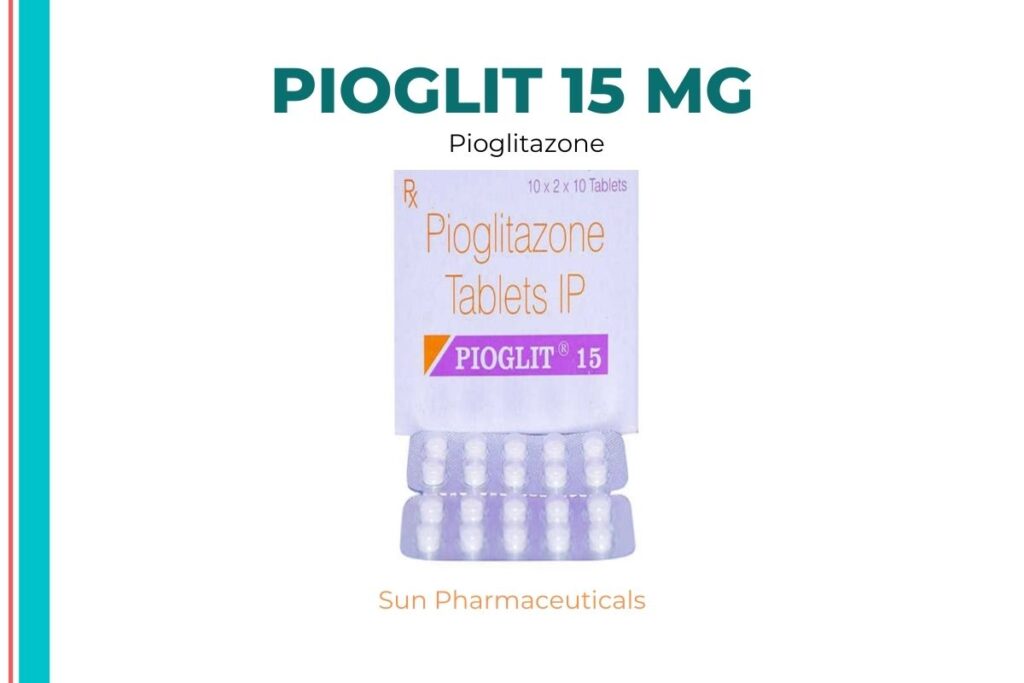Pioglit 15
Pioglit 15 is an anti-diabetic medication that belongs to the thiazolidinedione (TZD) class, generally known as ‘glitazones.’ It is used to treat type 2 diabetes mellitus (non-insulin-dependent). Type 2 diabetes is a condition in which the body does not produce enough insulin or the insulin it does produce does not function correctly. This is a kind of diabetes that typically manifests itself in adulthood.
Pioglit 15 contains Pioglitazone, a medication that assists your body in making better use of the insulin it generates when you have type 2 diabetes. 3-6 months after you begin taking Pioglitazone, your doctor will check to see if it is working.
Pioglit 15 may be administered alone or in combination with other medications (such as gliclazide, glibenclamide, glipizide, tolbutamide, or insulin) that have failed to manage blood sugar adequately. Additionally, pioglitazone may be administered in conjunction with insulin.
Pioglit 15 should be taken with or without food. However, for optimal outcomes, it should be taken at the same time of day each time. For the best guidance, your doctor will determine the appropriate dose, which may alter periodically based on your condition. Upper respiratory tract infection, headache, sinusitis, myalgia (muscle pain), and pharyngitis are the most often reported side effects of Pioglit 15.
Even if you feel better, do not stop taking Pioglit 15 without consulting your doctor, as your blood sugar level will continue to fluctuate. If you suddenly stop taking Pioglit 15, your blood sugar levels may rise, increasing your risk of vision loss (retinopathy), kidney problems (nephropathy), and nerve damage (neuropathy). Pioglit 15 should not be used if you have type 1 diabetes mellitus, are hypersensitive (allergic) to Pioglit 15 or any of its other ingredients, have heart failure or have had heart failure in the past, have diabetic ketoacidosis (a complication of diabetes characterized by rapid weight loss, nausea, or vomiting), have severe kidney or liver disease, or have bladder cancer. Kindly inform your doctor if you have a cardiac condition, are pregnant or planning to become pregnant, or are breastfeeding. Pioglit 15’s safety and efficacy in children under the age of 18 years have not been demonstrated, and so it should not be given to them.
Pioglit 15 uses Type 2 diabetic mellitus

Medicinal Advantages
Pioglit 15 is an antidiabetic medication (thiazolidinedione/glitazones) used in combination with a healthy diet and exercise to help individuals with type 2 diabetes control their blood sugar levels (hyperglycaemia). Pioglit 15 works by assisting in the restoration of your body’s normal insulin response, ultimately decreasing your blood sugar.
Use Instructions
Pioglit 15 should not be used unless a doctor has recommended it. Always take Pioglit 15 exactly as prescribed by your doctor. Your doctor will determine the frequency with which you should take your medications based on your medical condition. With a full glass of water, swallow the tablet.
Storage Keep out of direct sunlight and in a cool, dry area.
Pioglit 15 Side Effects
Each medication has some adverse effects. You may experience upper respiratory tract infection, headache, sinusitis, myalgia (muscle pain), and pharyngitis during the initial days of Pioglit 15 treatment (inflammation of pharynx located back of neck). However, they would be transient and might be alleviated after a period of time. However, if you continue to experience difficulty, consult a physician.
Adverse Drug Reactions
Oedema (fluid retention) is a possibility and might progress to congestive heart failure. Thus, the use of Pioglitazone in combination with insulin and in patients with heart failure may increase risk. Pioglitazone should not be used if you have renal disease as determined by a blood test. When used with or without insulin, pioglitazone has a propensity to significantly drop blood sugar levels. As a result, the doctor may reduce the insulin dose. Some women using Pioglitazone have experienced an increase in fractures. Patients with bladder cancer and macular oedema (fluid build-up in the macula portion of the retina of the eye) should visit their doctor before beginning treatment with Pioglitazone.
Interactions Between Drugs
Pioglitazone may interact with antidiabetic medications (gemfibrozil) and antibiotics (rifampicin). Therefore, inform your doctor if you are taking any of these medications prior to starting Pioglitazone.
Pioglitazone may raise the risk of lactic acidosis (a build-up of lactic acid in the blood) and hypoglycaemia when combined with alcoholic beverages.
Pioglitazone should be avoided in individuals with congestive heart failure (heart-related problems), type I diabetes, bladder cancer, oedema, liver illness, macular oedema, premenopausal anovulation, obesity (weight gain), or anemia since it may exacerbate the condition.
Safety Recommendations
ALCOHOL
To avoid unpleasant side effects, it is recommended that you avoid alcohol while taking Pioglitazone.
PREGNANCY
Pioglitazone is generally contraindicated during pregnancy. It is unknown whether pioglitazone can cause harm to an unborn child. Consult your doctor prior to using this medication if you are pregnant.
BREAST FEEDING
It is strongly recommended that you visit your physician prior to using Pioglitazone.
DRIVING
Pioglitazone will not impair your ability to drive or operate machinery, although you should exercise caution if you get abnormal vision.
LIVER
Pioglitazone should be used cautiously, even more so if you have a family history of liver disease/conditions. Your doctor may need to alter the dose.
KIDNEY
Pioglitazone should be used cautiously, even more so if you have a family history of kidney disease/conditions. Your doctor may need to alter the dose.
Advice on Diet and Lifestyle
Half of your plate should be starchy vegetables, a quarter protein, and a quarter whole grain.
Consume food at regular intervals. Avoid a lengthy gap between meals or snacks.
Regularly monitor your blood sugar level, especially if there are significant swings.
Each week, commit to at least 150 minutes of moderate-intensity physical activity and 15 minutes of vigorous exercise.
Weight loss should be gradual in order to maintain a healthy body mass index (18.5 to 24.9).
Substitute whole grain foods for refined carbohydrates and boost your diet of fruits, vegetables, and other fiber-rich foods.
Reduce saturated fat (or hidden fat) consumption in foods such as chips, crisps, pastries, biscuits, and samosas. For daily cooking, choose oils high in omega 3 fatty acids. Use palm oil, mustard oil, groundnut oil, rice bran oil, or safflower oil for frying.
Avoid stress, as it may cause your blood sugar level to rise. You can use stress management practices such as mindfulness, yoga, or meditation to help you handle stress caused by blood sugar fluctuations.
Make a point of purchasing low-fat dairy products (low-fat yoghurt, fat-free milk and cheese etc.).
Maintain a normal blood pressure (120/80) as much as feasible. Due to the fact that it lowers the risk of cardiovascular disease in diabetic people.
Special Guidance
Continue taking the medication even if you believe your blood sugar levels are stable. If you miss a dosage, do not double the dose; instead, visit your medical physician.
When using this medication, consume small frequent meals and prevent prolonged fasting. Be aware of hypoglycemic symptoms such as excessive sweating, dizziness, palpitations, shivering, severe thirst, dry mouth, dry skin, and frequent urination. If you encounter any of the symptoms listed above, immediately ingest 5-6 candies, 3 glucose biscuits, or 3 teaspoons of honey/sugar and see your physician. Keep them with you at all times, especially on lengthy journeys.
It is always preferable if your physician is aware of any underlying illnesses such as renal or liver disease, prior heart attack, or alcohol consumption before prescribing this medication.
Avoid alcohol consumption while taking this medication as it raises the risk of hypoglycemia (a dangerous drop in blood sugar that can be fatal in some situations) and lactic acidosis (when the lactic acid increases in the body which impacts the functioning of various organs in the body).
Quit smoking and limit carbohydrate-rich foods such as potatoes, rice, mangoes, bread, and sugar.
Additional Information: This item is non-refundable.
Glossary of Diseases and Conditions
Type 2 diabetes is a condition in which the body is unable to produce enough insulin or the insulin it does produce does not act correctly or is not properly utilized by the body. This can result in elevated blood sugar levels (hyperglycemia). Increased thirst, frequent urine at night, poor wound healing, increased hunger, weariness, and blurred eyesight are all symptoms of type 2 diabetes. In certain circumstances, weight increase may occur, whereas in rare instances, weight reduction may occur. Type 2 diabetes complications include neuropathy (nerve damage), nephropathy (kidney damage), retinopathy (damaged retina of the eyes or blindness), amputation of limbs, sexual dysfunction, and an increased risk of heart attack or stroke.
FAQs
Type-2 diabetes is uncommon in healthy children and adolescents, but it can occur in children who are obese, a condition known as Childhood Obesity.
Hypoglycemia is a term that relates to low blood sugar levels. It is a side effect of Pioglitazone. Hypoglycemia can develop if you skip or delay meals, drink alcohol, over-exercise, or combine this medication with another antidiabetic medication. It is critical to monitor blood sugar levels on a consistent basis.
If you experience symptoms such as increased hunger, increased thirst, frequent urination (typically at night), unexplained weight loss, exhaustion, blurred vision, slow wound/sore healing, or repeated infections, consult a physician since this could be a sign of type 2 diabetes.
If you feel as though your blood sugar is dropping and you are becoming weak, immediately consume sugar candies or sugary beverages. It will assist in balancing your body’s blood sugar levels. As a result, it is prudent to have sugar candies with you.
Metformin and Pioglitazone are two oral diabetes medications that work together to help regulate blood sugar levels. Metformin and pioglitazone are used in conjunction with diet and exercise to help persons with type 2 diabetes mellitus who do not require daily insulin injections regulate their blood sugar levels.
Avoid using Pioglitazone if you have or have ever had urinary bladder malignancy, diabetic eye illness (retinopathy), or kidney or liver problems. Consult a physician if the situation is critical.








Be the first to review “PIOGLIT 15 MG 10 Tablets”